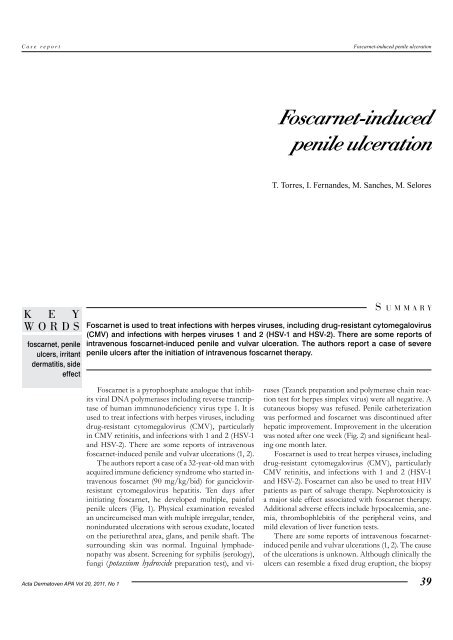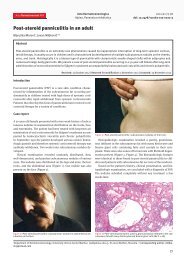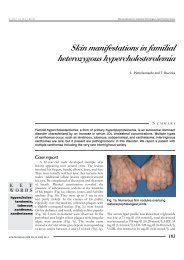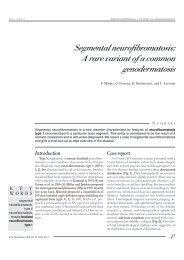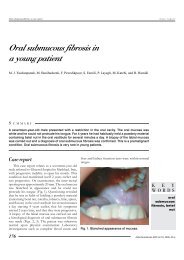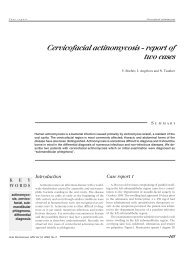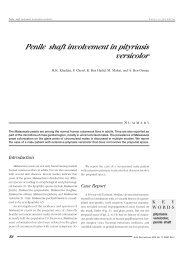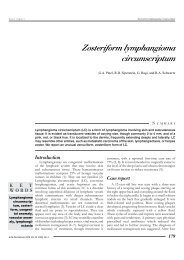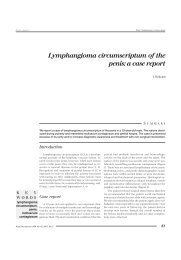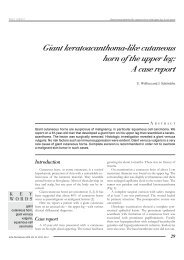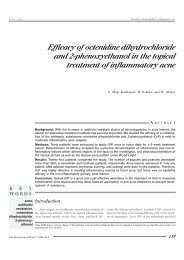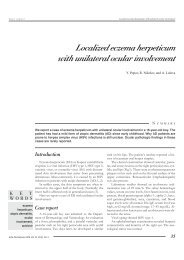Foscarnet-induced penile ulceration
Foscarnet-induced penile ulceration
Foscarnet-induced penile ulceration
You also want an ePaper? Increase the reach of your titles
YUMPU automatically turns print PDFs into web optimized ePapers that Google loves.
Case report<br />
<strong>Foscarnet</strong>-<strong>induced</strong> <strong>penile</strong> <strong>ulceration</strong><br />
<strong>Foscarnet</strong>-<strong>induced</strong><br />
<strong>penile</strong> <strong>ulceration</strong><br />
<br />
K E Y<br />
WORDS<br />
foscarnet, <strong>penile</strong><br />
ulcers, irritant<br />
dermatitis, side<br />
effect<br />
S UMMARY<br />
<strong>Foscarnet</strong> is used to treat infections with herpes viruses, including drug-resistant cytomegalovirus<br />
(CMV) and infections with herpes viruses 1 and 2 (HSV-1 and HSV-2). There are some reports of<br />
intravenous foscarnet-<strong>induced</strong> <strong>penile</strong> and vulvar <strong>ulceration</strong>. The authors report a case of severe<br />
<strong>penile</strong> ulcers after the initiation of intravenous foscarnet therapy.<br />
Acta Dermatoven APA Vol 20, 2011, No 1<br />
<strong>Foscarnet</strong> is a pyrophosphate analogue that inhibits<br />
viral DNA polymerases including reverse trancrip-<br />
<br />
used to treat infections with herpes viruses, including<br />
drug-resistant cytomegalovirus (CMV), particularly<br />
<br />
<br />
foscarnet-<strong>induced</strong> <strong>penile</strong> and vulvar <strong>ulceration</strong>s (1, 2).<br />
The authors report a case of a 32-year-old man with<br />
travenous<br />
foscarnet (90 mg/kg/bid) for ganciclovirresistant<br />
cytomegalovirus hepatitis. Ten days after<br />
initiating foscarnet, he developed multiple, painful<br />
<strong>penile</strong> ulcers (Fig. 1). Physical examination revealed<br />
an uncircumcised man with multiple irregular, tender,<br />
nonindurated <strong>ulceration</strong>s with serous exudate, located<br />
on the periurethral area, glans, and <strong>penile</strong> shaft. The<br />
surrounding skin was normal. Inguinal lymphadenopathy<br />
was absent. Screening for syphilis (serology),<br />
fungi (potassium hydroxide preparation test), and vi-<br />
tion<br />
test for herpes simplex virus) were all negative. A<br />
<br />
was performed and foscarnet was discontinued after<br />
hepatic improvement. Improvement in the <strong>ulceration</strong><br />
ing<br />
one month later.<br />
<strong>Foscarnet</strong> is used to treat herpes viruses, including<br />
drug-resistant cytomegalovirus (CMV), particularly<br />
<br />
<br />
patients as part of salvage therapy. Nephrotoxicity is<br />
a major side effect associated with foscarnet therapy.<br />
Additional adverse effects include hypocalcemia, anemia,<br />
thrombophlebitis of the peripheral veins, and<br />
mild elevation of liver function tests.<br />
There are some reports of intravenous foscarnet<strong>induced</strong><br />
<strong>penile</strong> and vulvar <strong>ulceration</strong>s (1, 2). The cause<br />
of the <strong>ulceration</strong>s is unknown. Although clinically the<br />
<br />
39
<strong>Foscarnet</strong>-<strong>induced</strong> <strong>penile</strong> <strong>ulceration</strong><br />
Case report<br />
Figure 1. Irregular, tender, nonindurated <strong>ulceration</strong>,<br />
located on the periurethral area, gland,<br />
and <strong>penile</strong> shaft.<br />
Figure 2. Ulceration improvement after <strong>penile</strong><br />
catheterization and discontinuation of foscarnet.<br />
<br />
support an acute dermatitis (3). Topical preparations<br />
vere<br />
irritant dermatitis, particularly in the subpreputial<br />
space in uncircumcised men, while topical prepa-<br />
<br />
<br />
in the urine and may be retained in the subpreputial<br />
space after urination. An irritant dermatitis secondary<br />
to cutaneous contact with foscarnet in the urine<br />
seems plausible, mainly because all reports of <strong>ulceration</strong><br />
have occurred early on in treatment when high<br />
dose regimens are used. Moreover, because of foscarnet<br />
nephrotoxicity, good hydration during therapy is<br />
recommended, increasing the frequency of urination<br />
and thus increasing the chance of genital <strong>ulceration</strong>.<br />
Good personal hygiene, including washing the genitals<br />
after urination, is recommended to reduce the occurrence<br />
of this side effect (5).<br />
Although the patient refused a biopsy, the development<br />
of the ulcers after starting foscarnet and the<br />
improvement with the cessation of the antiviral therapy<br />
allows us to assume that this is another case of<br />
foscarnet-<strong>induced</strong> genital ulcers.<br />
With the increasing number of patients with resistant<br />
herpes virus infections being treated with<br />
foscarnet, it is essential to be aware of this potential<br />
complication.<br />
R EFERENCES<br />
1. <br />
<br />
<br />
3. <br />
<br />
4. <br />
5. <br />
AUTHORS’<br />
ADDRESSES<br />
40<br />
Tiago Torres, MD, Department of Dermatology, Centro Hospitalar do Porto<br />
– Hospital de Santo António, Edifício das Consultas Externas do Hospital<br />
Geral Santo António, Ex. CICAP, Rua D. Manuel II, s/n, 4100 Porto, Portugal,<br />
E-mail: tiagotorres2002@hotmail.com<br />
Iolanda Fernandes, MD, same address, E-mail: iolandacfernandes@iol.pt<br />
Madalena Sanches, MD, same address, E-mail: madalenavsanches@gmail.com<br />
Manuela Selores, MD, same address, E-mail: dermat@sapo.pt<br />
Acta Dermatoven APA Vol 20, 2011, No 1


